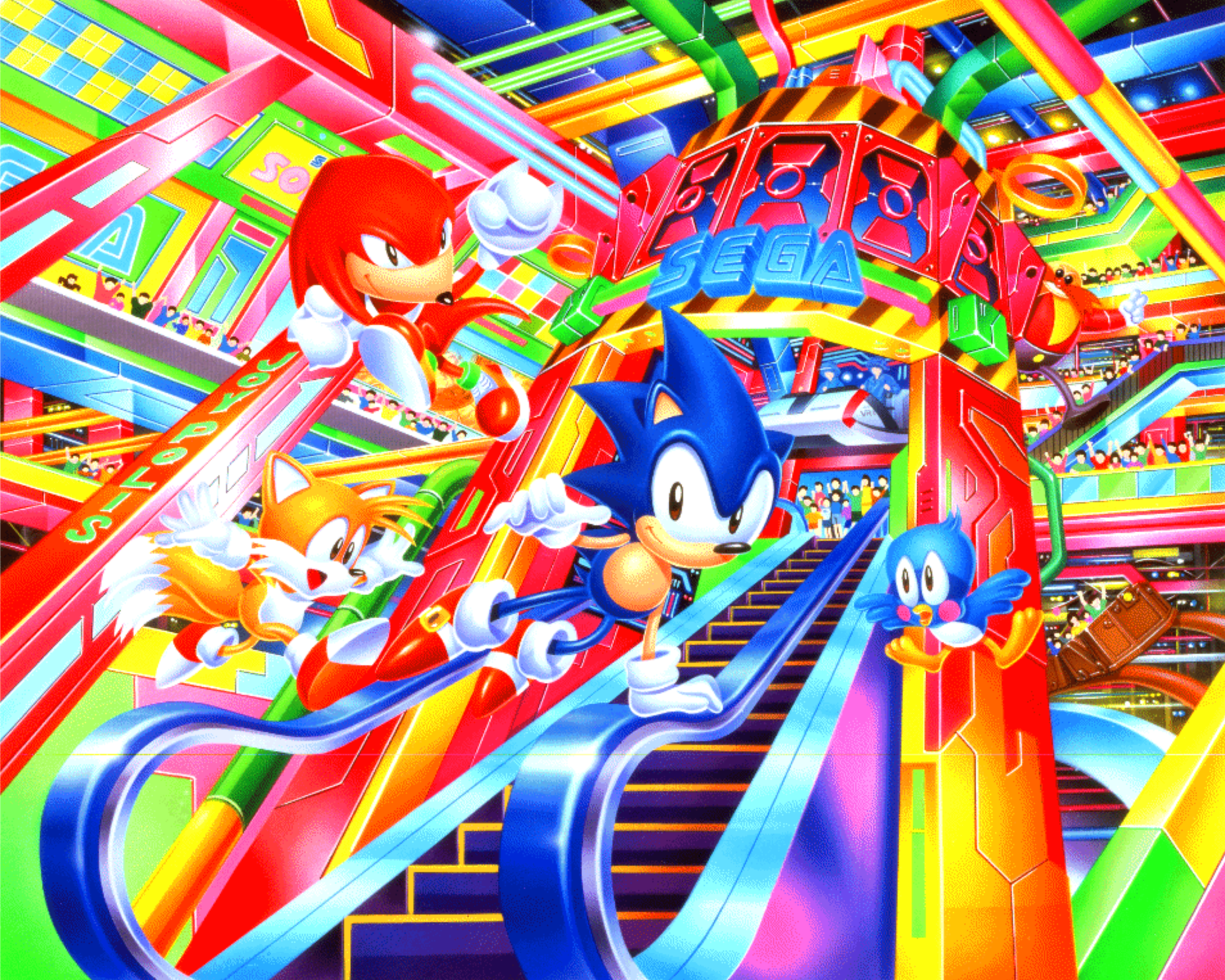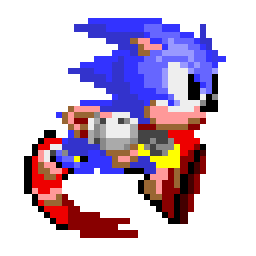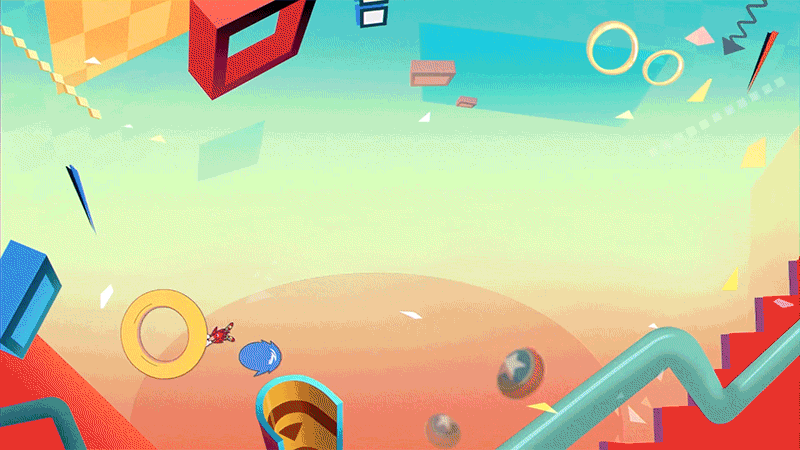A 25 Year Sonic Adventure
Featuring interviews with Nigel Kitching (script writer for Sonic the Comic) and Stealth (co-creator of Sonic Mania)

Sonic the Hedgehog is ingrained in most gamers’ minds; just as much as other iconic video game characters like Mario or Crash Bandicoot.He definitely occupies a permanent place in mine, in large part because Sonic the Hedgehog kicked off my interest in games as a whole. It also influenced where I am today.
I can still remember the exact date: 25th December 1994.
I couldn’t believe it as I unwrapped a box that revealed a Sega MegaDrive (Genesis in North America), MegaGames 1, EA Sports Double Header (containing EA Hockey and John Madden Football), and Sonic the Hedgehog 3 (a huge step up for me after playing the first Sonic game on a neighbours’ Sega Master System).
There’s even a picture of me playing it for the first time.
This is the story of how Sonic has helped me form a career, and why I’m hopeful for what the series can bring as it enters its 29th year on June 23rd.

The mid-nineties was all about Sonic. I’d watch the cartoons on Channel 4 on Sunday mornings (there was another cartoon on ITV1 as well); I’d even read the comics.
Back then, there was no internet, no way of reading magazines at 5 years old; just the playgrounds and the vague of rumours for what other people were doing on their own saves of Sonic 3, or the games that preceded it.
I was obsessed. The ‘blue blur’ wanted to save people, because it seemed like the right thing to do. Coincidentally, this was also when I was discovering Superman, through the Lois and Clark show that starred Dean Cain and Teri Hatcher. To note, those two will always be my Superman and Lois Lane, regardless of how politically-focused Dean Cain has become in recent times.
Looking back, it was a great time for new heroes. If I was born in any other decade, I may have grown up loving Doctor Who, but the early-nineties was an enigma; it had been off-air since 1989, and a TV Movie in ’96 did nothing to peak my interest at the time. It was all about Sonic and Superman.
A couple of years later, I’d still be playing Sonic 3, but now I’d be getting more of a fix through the comics. The Sonic the Comic variant in the UK opened up my eyes to how story could really work in a franchise like Sonic. Freedom fighters, new characters, sidekicks, and alter-egos were all introduced to me. One character that did stick out for me, was an evil-version of Super Sonic. Once Sonic was stressed or even felt angry, he would transform into Super Sonic; a maniacally-dark version of Sonic who only wanted to destroy, and not once felt compassion or guilt for his crimes.
The era of the comic was an incredible time, full of maturity and written in a way to not talk down to the young readers like myself in 1996.
Expanding the Sonic universe
Nigel Kitching was the main script-writer for the series until his departure in 2000, and he was gracious enough to answer a few questions about his time at Sonic the Comic.
SUPERJUMP
We’re at a point where people are looking back on the comic with great nostalgia, or even discovering it for the first time, thanks to the internet and even podcasts. Why do you think the stories are still discussed today?

NIGEL KITCHING
I suppose I’ll have to say because the stories were good. Not all of them, I’m quite aware that I wrote a few stinkers as fans sometimes like to remind me.
But when I wrote for Sonic the Comic I tried to remember how I felt when I read comics when I was a kid. Even then I could tell the difference between bland products and stuff where the creators cared about what they were doing. I saw no reason that I couldn’t put a bit of passion into the work. In the early days my editor was Richard Burton who was a real old school comic fan. Previously he’d edited 2000AD so I think he got what I was trying to do. He did tell me one time that perhaps my stories were getting a bit too complicated and to take care not to go too far. But I really think quality stands the test of time and we had a good bit of that. I need to mention Richard Elson here too. Before I started my scripts I called up Rich and we would discuss story ideas and there’s lots of his ideas in there. The idea to split Sonic and Super Sonic for example. I like to think I helped Rich too by writing great pictures for him. I also worked the same way with my old friend Nigel Dobbyn. Nigel contributed so much to those Knuckles stories. One of the best runs we did was instigated by Nigel telling me he fancied drawing a few different genres of story. So we had a horror story and a Western and so on.
I never thought that because you were writing for a young audience that you needed to write down. Kids are just young not stupid.
SUPERJUMP
Running Wild was the story that got me into Sonic the Comic at age 7, with evil Super Sonic twisting the concept on its head and him becoming a favourite character of mine. With this, do you think ‘story’ even has a place in a new Sonic game? Do you see a new game, or even a sequel to the movie, having Running Wild as a potential story thread someday?
NIGEL KITCHING
I felt Sonic the Comic was its own thing and had its own ‘universe’. So I’ve never thought about my stories being used elsewhere. Suppose it would be nice to see but it’s not likely to happen really. I remember Running Wild very well. I had a whole page in there somewhere of Super Sonic changing back to Sonic and realising what he had done whilst out of control. You need an artist like Rich to make a page like this come off. I need to watch the movie sometime — people have told me it’s pretty good.
SUPERJUMP
Did you ever think you’d be invited to events such as Summer of Sonic and a 25th anniversary event of the comic to celebrate the work of yours and others involved? Do you look back on your time at STC with fondness and nostalgia too?

NIGEL KITCHING
Well, I wasn’t that surprised when it happened to be honest. I’d seen something similar happen in the UK with US comics so I know how passionate fans are about stuff they like.
I look back at my time on STC with huge fondness. I worked with Richard Elson and I made a friend for life. I also worked with Nigel Dobbyn who had been a friend for years and I miss him a great deal. I’m sure people know but Nigel died in 2019. I also got to work with Mick McMahon who is an artist whose work I had admired for years. I also had great editors, I already mentioned Richard Burton but there’s also Deb Tate who was a pleasure to work with and really supportive. I got to know Lew Stringer who is a bit of a UK comics star in my opinion. Lots of other great people too like Carl Flint. I could go on.
So it wasn’t just the chance to write stories that I cared about, it was also the people. And I was actually making a good living working in comics which was what I’d always wanted. I was pretty lucky I think.
SUPERJUMP
Your stories still resonate 25 years on, such as Metallix, Running Wild, Doomsday, the Sonic Adventure saga. Are there any that are a favourite of yours, or even some that you can imagine a sequel to, even after all these years?
NIGEL KITCHING
All the ones you mention above. I also liked Smokey and The Badnik (title supplied by Rich Elson). I liked writing and drawing Decap Attack; some of these I wrote with another old friend Richard Piers Rayner. I kind of remember story moments really and writing silly dialogue for characters like Carmy Bee. Porker Lewis was fun to write too. I was fond of my last (I think) 10 issue run on the comic and pleased with how we handled the death of Johnny Lighfoot. Some of Rich’s best art on the series too I think. I liked my take on the Wicker Man (a favourite film of mine) in the Knuckles series. Nigel came up with some stunning artwork which he was kind enough to give me. There’s too much really and, as you suggested, it’s all very nostalgic now. All I remember is the good stuff.
SUPERJUMP
Finally, were there any storylines you wanted to further explore but ultimately couldn’t?
NIGEL KITCHING
I’m sure there were but they would still have been just story ideas and quite vague even then and impossible to really recall all these years later. I know I wanted to do more with Death-Trap. I liked those three characters quite a bit. I also had big (but forgotten) plans for the 3 Houses of Drakon but there was never enough space — I think I was being a little overambitious in this case. I know I’d planned to make Sonic older and wiser after the death of Johnny — I perhaps had made him a bit too much of a dick.
Bit scary to think this was 20 years ago actually.

Sonic the Comic lasted until 2002, where it unfortunately became a comic of re-printed stories and much-shorter stories due to the limits that the publisher, Fleetway insisted upon. But as I said to Nigel, it still lives on through podcasts and an online series.
When fans take the wheel
With PlayStation being my main console in 1997, my eyes went towards Lara Croft, Crash Bandicoot and the rest. Even my eight-year old self knew that Sonic was in a lull.
It wasn’t until I saw Sonic Adventure that my interest piqued again; a full-3D action-RPG game. It’s only in recent years that I’ve come to appreciate the game fully; to enjoy it for what it is, and what Sega was up against at the time, from the PlayStation 2, to other third-party publishers fully realising their ideas for the next-generation.
But it was during this time that I was re-discovering the classic Sonic games through the internet. Or, to put it plainly; emulators.
This is when I came across a revelation; that a ‘beta’ of Sonic 2 had been on the internet for the last few years, and it demonstrated zones that had been entirely cut from the final version, either through playable levels like Hidden Palace Zone, or mere placeholder names like ‘Dust Hill’.
From this, I discovered forums that would demonstrate ‘hacks’ of previous Sonic games. These contained new levels, or the cut-levels now in Sonic 2, or even entirely new ‘Boss Rush’ modes. These ‘hacks’ were often more akin to fan-made DLC.
One that I still remember to this day, is a hack that enabled you to play as Knuckles in Sonic 1; a feat that was impossible through normal means. This was done by an individual called Stealth, a programmer who I had on my podcast, PAL KEYS last year.

His talents subsequently led him to help develop Sonic Mania with another programmer; Taxman, a game which I regard as highly as the Mega Drive entries.
He was gracious enough to answer some of my questions.
Stealth on the ‘Knuckles in Sonic 1’ hack:
I did the hack mainly because I saw it as a challenge. Sega has standards and goals to see if it makes sense to do it; I had the benefit of seeing this on the other side with Sonic Mania.
I used the lock-on code from Sonic 2 & Knuckles to implement Knuckles into Sonic 1, and I discovered that there was a palette I could use for Knuckles as well. So no level was compromised.
I had disassembled Knuckles in Sonic 2 into code, so I could see the routines and the hex code of how everything worked. It turns out that there’s a chip on the Sonic and Knuckles cartridge, that contains a complete version of Knuckles in Sonic 2, so some of the data is still read off the Sonic 2 cartridge, and once they were combined, it made the game you’ve been playing since 1994.
With the disassembly, I saw exactly where the code was located so I could have Knuckles into Sonic 1, but what made it slightly easier, was that both games have a similar engine, but with optimisations in Sonic 2.
Super Knuckles was just something I thought would be fun to do; even though Super Sonic didn’t appear until Sonic 2, I wanted to add something else to make it as close to a Sega effort as possible.
Overall it took me a year to do, but looking back I’d be tempted to implement more original features, but I’m happy with how it turned out.
Stealth on the Sonic 3 and Knuckles concept on iOS:
We were pretty sure it would be possible, but we wanted to create it to push it through to Sega as another project to work on. We did talk about it but it doesn’t seem like it’s going to happen, and it is hard to talk about as I’ve directly worked with Sega because of Sonic Mania, but it is out there that the prominent reason is to do with the music rights.
(I mention about playing the PC version of Sonic 3 that had totally different music)
That was brought up as an option, to implement that into this remastered port, but there were other issues to do with this music too, so unfortunately it’s something that Sega don’t want to pursue for now, but the concept was a fun project to do regardless.
Stealth on Sonic MegaMix and Sonic 1 & 2 Remastered for iOS:
With 1 and 2 in particular, I wanted to make sure that we got the extra characters in such as Tails and Knuckles, so they had their own routes in Chemical Plant and Marble Zone for example. Also the shields from Sonic 3and Super forms in both remastered releases as I simply wanted it to be implemented.
There was a boss rush stage called ‘Egg Gauntlet’ that we wanted in Sonic 2, but due to time we just didn’t have time to implement it.
The assets of Hidden Palace were extracted from the beta of Sonic 2, and Christian ‘Taxman’ Whitehead created the assets of the boss and the whole stage to make Hidden Palace its own.

Sealth on his and Christian’s work on Sonic Mania and ‘Plus’:
We had someone at Sega who was fighting our corner (Aaron Webber, who recently announced his departure from the role) and eventually allowed us to create a pitch, and eventually the higher-ups gave the approval for us to create Mania.
But it was mainly thanks to Aaron who made it all happen and a lot of credit should go to him.
I think we ended up with a game that was pretty good, and a lot of people seemed to agree. It was nice to see the excitement and I was glad that I was able to put out something that a lot of people had fun with.
We had to be silent on a lot of stuff while we were developing Mania, but people seem to think that a contractor like me or Christian would be able to make announcements regarding the game, but it’s just not how it works. We would work with Sega regarding the zones and even the music as to how it would work, and it was a fun experience from start to finish, from Mania to Mania Plus.
At the end of Sonic Mania I was admittedly curious as to what a follow-up game could entail, but we can only see what the future holds on that.
Sonic boom
We’ve seen high moments for the franchise since 2001, with games like Sonic Heroes, Sonic Colors, and Sonic Generations, culminating with Sonic Mania in 2017, a game — in some ideal, alternate timeline — that could easily have graced the Sega Saturn in 1996.
But there have also been lots of lows; too many to count unfortunately. Clear examples that stand out for me are Sonic the Hedgehog (2006), Sonic Forces, Sonic the Hedgehog 4, and Sonic Lost World.

Even when Sega themselves appear to drop the ball, though, the fans always seem to be there to pick it up again. Sonic Mania and the ‘hacking’ community is a great example of this. These projects also demonstrate that there are people out there who truly understand what makes a Sonic game good.
As I said in my Finding Lara Croft piece from January:
“Sega has responded to this collision of old and new fans by releasing games like Sonic Generations and Sonic Mania, where they are offering both a clear nostalgic experience alongside upgraded visuals and new content.”
This still needs to be the standard for years to come. Without recognising both the “old and new” fans, the series might fail on both fronts and ultimately become irrelevant. It would be a shame if Sega’s iconic mascot was simply lost to time.
Both the fan projects and the comics demonstrate that there are plenty of possibilities for Sonic going forward. There is much fertile ground yet to be uncovered in the video games. For example, I’d love to see the ‘evil Super Sonic’ character emerge in the games — he would be a unique addition (in either the 2D or 3D games) — that fans haven’t seen before. Granted, we have seen the ‘evil twin’ (Shadow) in Sonic Adventure 2, but he wasn’t the same as evil Super Sonic; the latter was the manifestation of Sonic’s stress, fears, and hidden darkness. The idea of featuring a character like this as an enemy throughout various levels and boss stages is a tantalising possibility.

Whether it’s the natural beauty of Green Hill Zone, the anxiety-inducing rising water in Chemical Plant Zone, or the endless blue of Sky Sanctuary Zone, I have so many wonderful memories of the series, and it means a great deal to me. To some extent, Sonic defined my ideas around good and bad games — even in reference to the Sonic franchise itself.
I could write another 1,000 words on the series. The music alone warrants an entire article, as does the Sonic 3 Beta. Then there’s my experience of being bulled in school simply because I created a Sonic website to practice my web design skills. Oh, and I can’t forget attending the Sonic the Comic 25th anniversary convention in Manchester in 2018.
So, there’s a lot to be said. In all all though, the first three Sonic games — particularly Sonic 3 & Knuckles — are among my all-time favourite games. These are games that can, and should, be studied for the way they bring together their constituent parts to form an experience that is utterly sublime. Sonic exemplifies some important lessons about 2D game design as a whole actually. And these games in particular are examples of the best of Sonic — this is what Sonic can be when done well, and done right.
It’s not just that I’m a fan of Sonic; he has had an enormous impact on my life as a whole. The games and comics inspired me to develop a career in writing (it’s why you’re reading this right now). And I’m forever grateful for that day in 1994 that started it all.
If I had the opportunity to travel back in time and speak to myself on that fateful day in 1994, I’d tell myself this:
“Value your time with this game; it’s going to help define a lot of you, and a lot of what you’re going to be carving into a career.
Don’t worry about what school you choose for secondary, or what people may say; you’re on the right track, and you will turn these energies into a career you can be proud of.
Enjoy this time, read as much as you can and know that whatever comes next, nothing will come close to discovering how a blue blur and his friends on Mobius always fight for the right thing. Keep going, you’ll be fine.”

